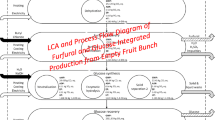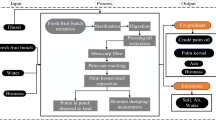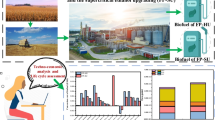Abstract
This paper presents a life cycle assessment of two alternative processes for the production of bio-oil from Malaysian oil palm empty fruit bunch (EFB), namely, fast pyrolysis and hydrothermal liquefaction, in which limited studies have been reported in the literature. In this study, both processes were evaluated and compared in terms of their impacts to the environment, specifically based on the selected impact categories: global warming potential (GWP), acidification, eutrophication, toxicity, and photochemical-oxidant formation. The results indicated that fast pyrolysis process of EFB caused more severe impact on the environment compared to hydrothermal liquefaction process. Fast pyrolysis process caused almost 50 % more GWP impact compared to hydrothermal liquefaction process, due to both high energy demand in the drying process and high-temperature operation of fast pyrolysis. Other than that, the assessment on other environmental impacts indicated that hydrothermal liquefaction operation is more environmentally benign compared to fast pyrolysis due to the reduced energy consumption. Lastly, sensitivity analysis involving three scenarios (change in bio-oil yield, thermal efficiency of boilers, and thermal efficiency of dryers), respectively, were constructed and presented.






Similar content being viewed by others
References
Abdullah N, Gerhauser H (2008) Bio-oil derived from empty fruit bunches. Fuels 87:2606–2613
Akhtar J, Amin NAS (2011) A review on process conditions for optimum bio-oil yield in hydrothermal liquefaction of biomass. Renew Sustain Energy Rev 15:1615–1624
Akhtar J, Kuang SK, Amin NAS (2010) Liquefaction of empty palm fruit bunch (EPFB) in alkaline hot compressed water. Renew Energy 35:1220–1227
Amor MB, Gaudreault C, Pineau PO, Samson R (2014) Implications of integrating electric supply dynamics into life cycle assessment: a case study of renewable distributed generation. Renew Energy 69:410–419
Benedetto LD, Klemeš J (2009) The Environmental Performance Strategy Map: an integrated LCA approach to support the strategic decision-making process. J Clean Prod 17:900–906
Benedetto LD, Klemeš J (2010) The environmental bill of material and technology routing: an integrated LCA approach. Clean Technol Environ Policy 12:191–196
Brown TR, Wright MM, Brown RC (2011) Estimating profitability of two biochar production scenarios: slow pyrolysis vs fast pyrolysis. Biofuels Bioprod Biorefin 5:54–68
Carnegie Mellon University Green Design Institute, Economic Input-Output Life Cycle Assessment (EIO-LCA) US 2002 (428 sectors) Purchaser Model [Internet] (2014) www.eiolca.net/. Accessed 22 June 2014.
Chan YH, Dang KV, Yusup S, Lim MT, Zain AM, Uemura Y (2014) Studies on catalytic pyrolysis of empty fruit bunch (EFB) using Taguchi’s L9 Orthogonal Array. J Energy Inst 87:227–234
Chan YH, Yusup S, Quitain AT, Tan RR, Sasaki M, Lam HL, Uemura Y (2015) Effect of process prarameters on hydrothermal liquefaction of oil palm biomass for bio-oil production and its life cycle assessment. Energy Convers Manag 104:180–188
Cherubini F, Ulgiati S (2010) Crop residues as raw materials for biorefinery systems—a LCA case study. Appl Energy 87:47–57
Collard F-X, Blin J (2014) A review on pyrolysis of biomass constituents: mechanisms and composition of the products obtained from the conversion of cellulose, hemicellulose and lignin. Renew Sustain Energy Rev 38:594–608
Čuček L, Klemeš JJ, Kravanja Z (2012) A Review of Footprints analysis tools for monitoring impacts on sustainability. J Clean Prod 34:9–20
Čuček L, Klemeš JJ, Varbanov PS, Kravanja Z (2015) Significance of environmental footprints for evaluating sustainability and security of development. Clean Technol Environ Policy 17:2125–2141
Dang Q, Yu C, Luo Z (2014) Environmental life cycle assessment of bio-fuel production via fast pyrolysis of corn stover and hydroprocessing. Fuel 131:36–42
Fortier M-OP, Roberts GW, Stagg-Williams SM, Sturm BSM (2014) Life cycle assessment of bio-jet fuel from hydrothermal liquefaction of microalgae. Appl Energy 122:73–82
Guinée JB (ed) (2002) Handbook of life cycle assessment: operational guide to the ISO standards. Kluwer Academic Publishers, Dordrecht
Hammond J, Shackley S, Sohi S, Brownsort P (2011) Prospective life cycle carbon abatement for pyrolysis biochar systems in the UK. Energy Policy 39:2646–2655
Hunt RG, Franklin WE (1996) LCA—how it came about—personal reflections on the origin and the development of LCA in the USA. Int J Life Cycle Assess 1:4–7
Iribarren D, Peters JF, Dufour J (2012) Life cycle assessment of transportation fuels from biomass pyrolysis. Fuel 97:812–821
ISO 14040 (1997) Environmental management—life cycle assessment—principles and framework. International Organization of Standardization, Geneva
Joelsson JM, Gustavsson L (2010) Reduction of CO2 emission and oil dependency with biomass-based polygeneration. Biomass Bioenergy 34:967–984
Khoo HH (2009) Life cycle impact assessment of various waste conversion technologies. Waste Manag 29:1892–1900
Klemeš J (ed) (2015) Assessing and measuring environmental impact and sustainability. Butterworth-Heinemann (Elsevier), Oxford
Liu X, Saydah B, Eranki P, Colosi LM, Mitchell BG, Rhodes J, Clarens AF (2013) Pilot-scale dara provide enhanced estimates of the life cycle energy and emissions profile of algae biofuels produced via hydrothermal liquefaction. Bioresour Technol 148:163–171
Mazaheri H, Lee KT, Bhatia S, Mohamed AR (2010) Subcritical water liquefaction of oil palm fruit press fiber for the production of bio-oil: effect of catalysts. Bioresour Technol 101:745–751
Ng WPQ, Lam HL, Ng FY, Kamal M, Lim JHE (2012) Waste-to-wealth: green potential from palm biomass in Malaysia. J Clean Prod 34:57–65
Ng BJH, Zhou J, Giannis A, Chang VWC, Wang JY (2014) Environmental life cycle assessment of different domestic wastewater streams: policy effectiveness in a trophical urban environment. J Environ Manag 140:60–68
Ning SK, Hung MC, Chang YH, Wan HP, Lee HT, Shih RF (2013) Benefit assessment of cost, energy, and environment for biomass pyrolysis oil. J Clean Prod 59:141–149
Omar R, Idris A, Yunus R, Khalid K, Aida Isma MI (2011) Characterization of empty fruit bunch for microwave-assisted pyrolysis. Fuel 90:1536–1544
Patel M, Zhang X, Kumar A (2016) Techno-economic and life cycle assessment on lignocellulosic biomass thermochemical conversion technologies: a review. Renew Sustain Energy Rev 53:1486–1499
Qian Y, Zuo C, Tan J, He J (2007) Structural analysis of bio-oils from sub- and supercritical water liquefaction of woody biomass. Energy 32:196–202
Sabil KM, Aziz MA, Lal B, Uemura Y (2013) Effects of torrefaction on the physiochemical properties of oil palm empty fruit bunches, mesocarp fiber and kernel shell. Biomass Bioenergy 56:351–360
Sangaletti-Gerhard N, Romanelli TL, Vieira TMF, Navia R, Regitano-d’Arce MAB (2014) Energy flow in the soybean biodiesel production chain using ethanol as solvent extraction of oil from soybeans. Biomass Bioenergy 66:39–48
Sathre R (2014) Comparing the heat of combustion of fossil fuels to the heat accumulated by their lifecycle greenhouse gases. Fuel 115:674–677
Savage PE, Levine RB, Huelsman CM (2010) Hydrothermal processing of biomass. In: Crocker M (ed) Thermochemical conversion of biomass to liquid fuels and chemicals. The Royal Society of Chemistry, Cambridge, pp 192–221
Shekarchian M, Moghavvemi M, Mahlia TMI, Mazandarani A (2011) A review on the pattern of electricity generation and emissions in Malaysia from 1976 to 2008. Renew Sustain Energy Rev 15:2629–2642
Sulaiman F, Abdullah N (2011) Optimum conditions for maximizing pyrolysis liquids of oil palm empty fruit bunches. Energy 36:2352–2359
The greenhouse gases, regulated emissions, and energy use in transportation (GREET) model (2013) https://greet.es.anl.gov/. Accessed 22 June 2014.
Woon KS, Lo IMC (2014) Analyzing environmental hotspots of proposed landfill extension and advanced incineration facility in Hong Kong using life cycle assessment. J Clean Prod 75:64–74
Yu C, Yulong W, Peiling Z, Derun H, Mingde Y, Chun L, Zhen C, Ji L (2012) Direct liquefaction of Dunaliella tertiolecta for bio-oil in sub/supercritical ethanol-water. Bioresour Technol 124:190–198
Acknowledgments
This research is supported by Yayasan Universiti Teknologi PETRONAS—Fundamental Research Grant (YUTP-FRG) and is in collaboration with De La Salle University, Philippines and Kumamoto University, Japan.
Author information
Authors and Affiliations
Corresponding author
Rights and permissions
About this article
Cite this article
Chan, Y.H., Tan, R.R., Yusup, S. et al. Comparative life cycle assessment (LCA) of bio-oil production from fast pyrolysis and hydrothermal liquefaction of oil palm empty fruit bunch (EFB). Clean Techn Environ Policy 18, 1759–1768 (2016). https://doi.org/10.1007/s10098-016-1172-5
Received:
Accepted:
Published:
Issue Date:
DOI: https://doi.org/10.1007/s10098-016-1172-5




